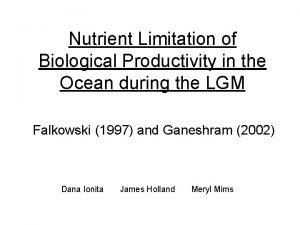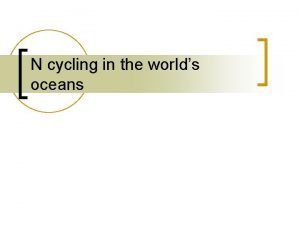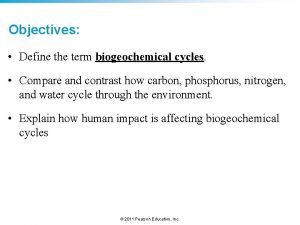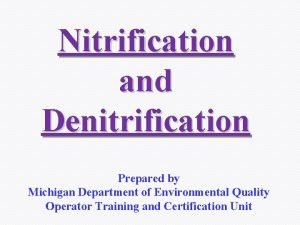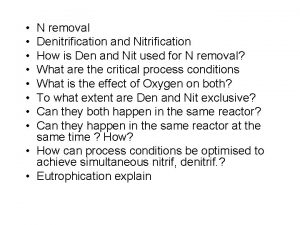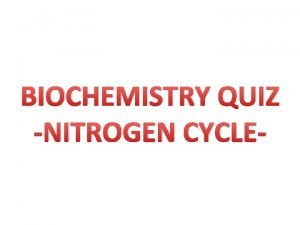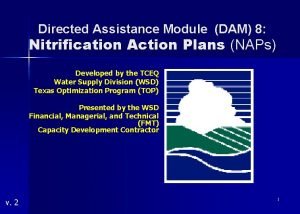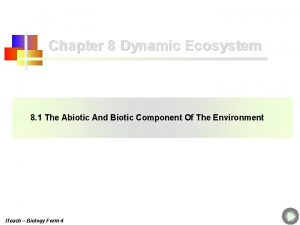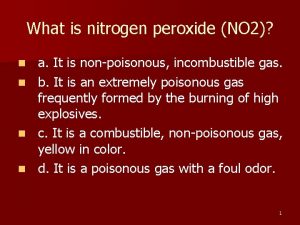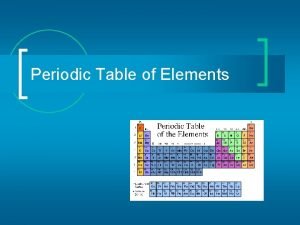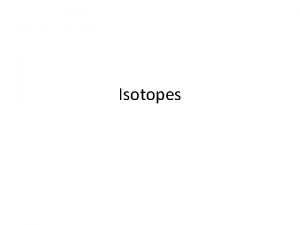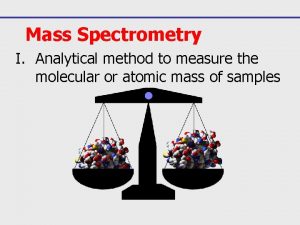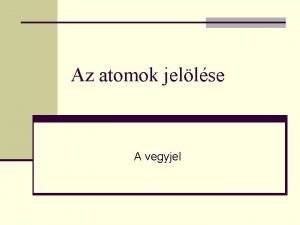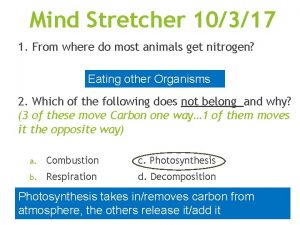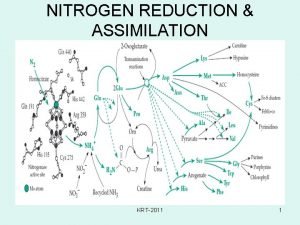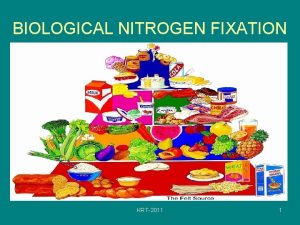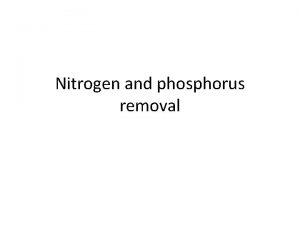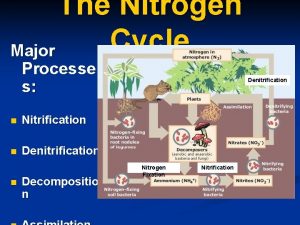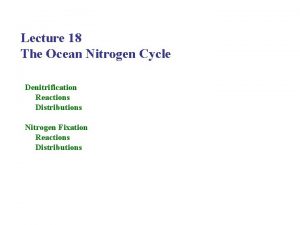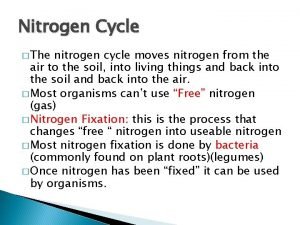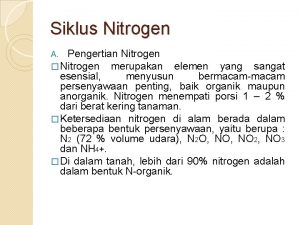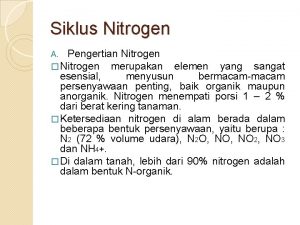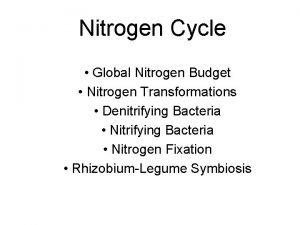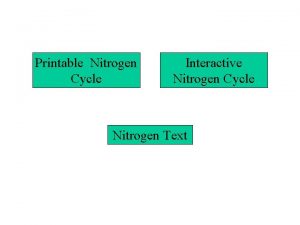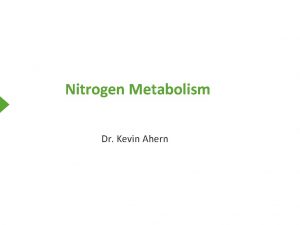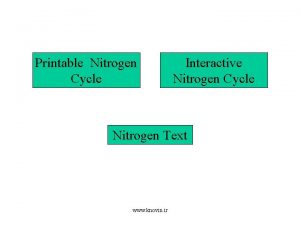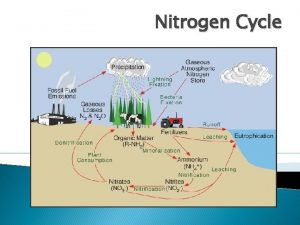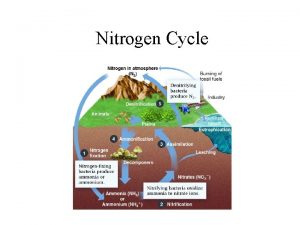6 Nitrification 7 Denitrification KRT2011 1 Some nitrogen




















![Rhizobium Root Nodules The picture above shows a clover root nodule. Available from [Internet] Rhizobium Root Nodules The picture above shows a clover root nodule. Available from [Internet]](https://slidetodoc.com/presentation_image_h/16d97d00eeac82b63e886d1c256fefcb/image-21.jpg)


- Slides: 23

6. Nitrification 7. Denitrification KRT-2011 1

Some nitrogen fixing organisms • Free living aerobic bacteria – Azotobacter – Beijerinckia – Klebsiella – Cyanobacteria (lichens) • Free living associative bacteria – Azospirillum • Free living anaerobic bacteria • Symbionts – Clostridium – Rhizobium (legumes) – Desulfovibrio – Frankia (alden trees) – Purple sulphur bacteria – Purple non-sulphur bacteria – Green sulphur bacteria KRT-2011 2

Some nitrogen fixing organisms KRT-2011 3

Estimated Average Rates of Biological N 2 Fixation Organism or system Free-living microorganisms Cyanobacteria Azotobacter Clostridium pasteurianum N 2 fixed (kg ha-1 y-1) 25 0. 3 0. 1 -0. 5 Grass-Bacteria associative symbioses Azospirillum 5 -25 Cyanobacterial associations Gunnera Azolla Lichens 10 -20 300 40 -80 Leguminous plant symbioses with rhizobia Grain legumes (Glycine, Vigna, Lespedeza, Phaseolus) Pasture legumes (Trifolium, Medicago, Lupinus) 50 -100 100 -600 Actinorhizal plant symbioses with Frankia Alnus Hippophaë Ceanothus Coriaria KRT-2011 Casuarina 40 -300 1 -150 1 -50 50 -150 50 4

Rank of Biological Nitrogen Fixation N 2 fixing system Rhizobium-legume Nitrogen Fixation (kg N/ha/year) 50 - 600 Cyanobacteria- moss 10 - 300 Rhizosphere associations Free- living 5 - 25 0. 1 - 25 KRT-2011 5

Nitrogen Fixation • Semua bacteria fiksasi nitrogen menggunakan conserved enzyme complex yang disebut Nitrogenase • Nitrogenase tersusun dari dua subunits: an iron -sulfur protein dan a molybdenum-iron-sulfur protein • Aerobic organisms face special challenges to nitrogen fixation karena nitrogenase inactivasi bila oxygen bereaksi dengan iron component of the proteins KRT-2011 6

Nitrogenase KRT-2011 7

Types of Biological Nitrogen Fixation Free-living (asymbiotic) • Cyanobacteria • Azotobacter Associative • Rhizosphere–Azospirillum • Lichens–cyanobacteria • Leaf nodules Symbiotic • Legume-rhizobia • Actinorhizal-Frankia KRT-2011 8

Examples of N 2 fixing plants Mesquite, Acacia, Palo Verde Symbionts are Rhizobium & Bradyrhizobium Lupines - Bradyrhizobium


Root nodules

Free-living N 2 Fixation Energy • 20 -120 g C used to fix 1 g N Combined Nitrogen • nif genes tightly regulated • Terhambat pada NH 4+ and NO 3 - rendah (1 μg g-1 soil, 300 μM) Oxygen • • • Menghindar (anaerobes) Microaerophilly Respiratory protection Specialized cells (heterocysts, vesicles) Spatial/temporal separation Conformational (=penyesuaian diri? ) protection KRT-2011 12

Heterocyst KRT-2011 13

Azolla pinnata (left) 1 cm. Anabaena from crushed leaves Of Azolla. KRT-2011 14

Simbiosis Anabaena-Azolla KRT-2011 15

Frankia and Actinorhizal Plants • Actinomycetes (Gram +, filamentous); septate hyphae; spores in sporangia; thick-walled vesicles Frankia vesicles showing thick walls that confer protection from oxygen. Bars are 100 nm. KRT-2011 16

Alder and the other woody hosts of Frankia are typical pioneer species that invade nutrient-poor soils. These plants benefit from the nitrogenfixing association, while supplying the bacterial symbiont with photosynthetic products. KRT-2011 17

Actinorhizal Plant Hosts Family Genera Betulaceae Alnus Casuarinace Allocasuarina, Ceuthostoma, ae Gymnostoma Myricaceae Comptonia, Myrica Elaeagnacea Elaeagnus, Hippophaë, Shepherdia e Rhamnaceae Ceanothus, Colletia, Discaria, Kentrothamnus, Retanilla, Talguenea, Trevoa Rosaceae Cercocarpus, Chamaebatia, Cowania, Dryas, Purshia Coriariaceae Coriaria Datiscaceae Datisca KRT-2011 18

Legume-Rhizobium Symbiosis • The subfamilies of legumes (Caesalpinioideae, Mimosoideae, Papilionoideae), 700 genera, and 19, 700 species of legumes COnly about 15% of the species have been evaluated for nodulation CRhizobium CGram -, rod CMost studied symbiotic N 2 -fixing bacteria CNow subdivided into several genera CMany genes known that are involved in nodulation (nod, nol, noe genes) KRT-2011 19

Taxonomy of Rhizobia Genus Species Host plant Rhizobium leguminosarum bv. trifolii “ bv. viciae “ bv. phaseoli tropici etli Trifolium (clovers) Pisum (peas), Vicia (field beans), Lens (lentils), Lathyrus Phaseolus (bean), Leucaena Phaseolus (bean) Sinorhizobium meliloti fredii saheli teranga Melilotus (sweetclover), Medicago (alfalfa), Trigonella Glycine (soybean) Sesbania, Acacia Bradyrhizobium japonicum elkanii liaoningense Glycine (soybean) Azorhizobium caulinodans Sesbania (stem nodule) ‘Meso rhizobium’ loti huakuii ciceri tianshanense mediterraneum Lotus (trefoil) Astragalus (milkvetch) Cicer (chickpea) [Rhizobium] galegae Galega (goat’s rue), Leucaena Photorhizobium spp. KRT-2011 Cicer (chickpea) Aeschynomene (stem nodule) 20
![Rhizobium Root Nodules The picture above shows a clover root nodule Available from Internet Rhizobium Root Nodules The picture above shows a clover root nodule. Available from [Internet]](https://slidetodoc.com/presentation_image_h/16d97d00eeac82b63e886d1c256fefcb/image-21.jpg)
Rhizobium Root Nodules The picture above shows a clover root nodule. Available from [Internet] KRT-2011 21

Rhizobium Root Nodules KRT-2011 22

A few legumes (such as Sesbania rostrata) have stem nodules as well as root nodules. Stem nodules (arrows) are capable of photosynthesis as well as nitrogen fixation. KRT-2011 23
 Redfield ratio
Redfield ratio Heterotrophic denitrification
Heterotrophic denitrification Quizlet
Quizlet Nitrification rate
Nitrification rate Aerobic nitrification
Aerobic nitrification Nitrification
Nitrification Nitrification is indicated by the letter(s) _____.
Nitrification is indicated by the letter(s) _____. Nitrification action plan
Nitrification action plan They say it only takes a little faith to move a mountain
They say it only takes a little faith to move a mountain Some say the world will end in fire some say in ice
Some say the world will end in fire some say in ice Ice cream countable and uncountable nouns
Ice cream countable and uncountable nouns Some trust in horses
Some trust in horses Contact and non contact forces
Contact and non contact forces Sometimes you win some sometimes you lose some
Sometimes you win some sometimes you lose some Fire and ice diamante poem
Fire and ice diamante poem N2 covalent bond
N2 covalent bond Kitar nitrogen
Kitar nitrogen Nitrogen peroxide
Nitrogen peroxide Nitrogen narcosis
Nitrogen narcosis Nitrogen periodic table square
Nitrogen periodic table square Argon hyphen notation
Argon hyphen notation Quadrupole mass analyzer
Quadrupole mass analyzer H vegyjel
H vegyjel Traveling nitrogen passport answers
Traveling nitrogen passport answers
